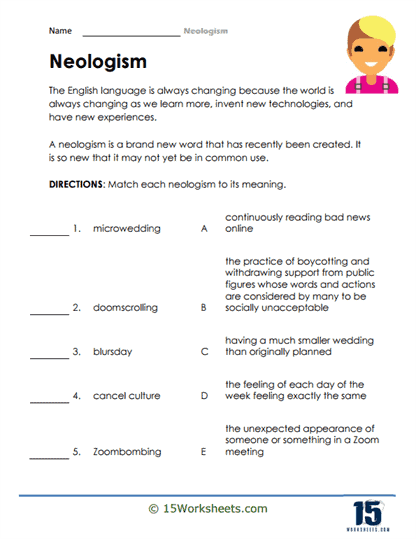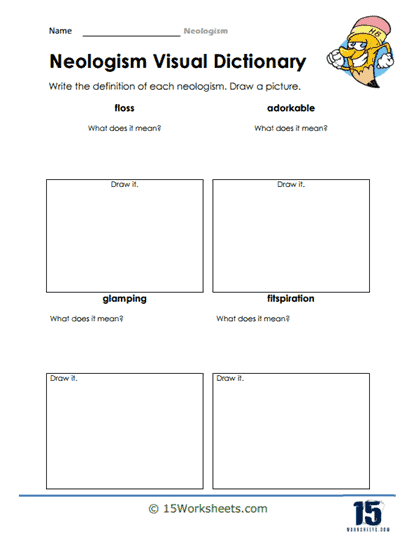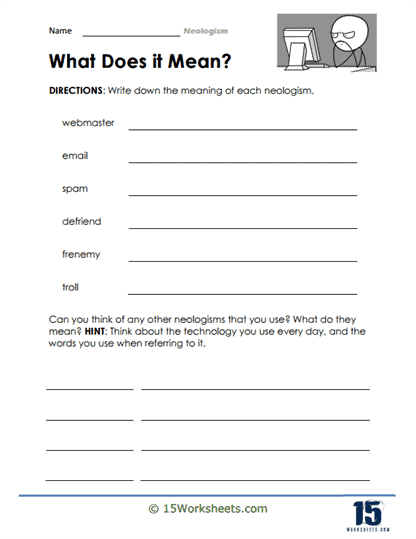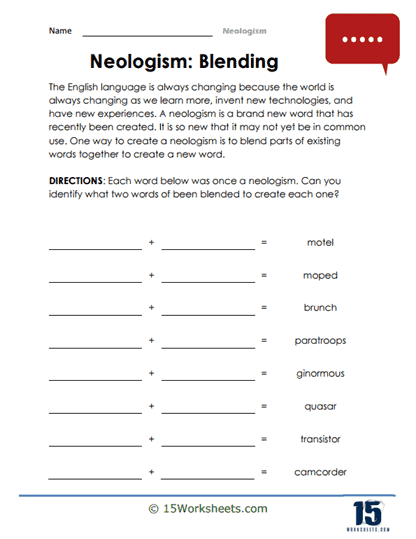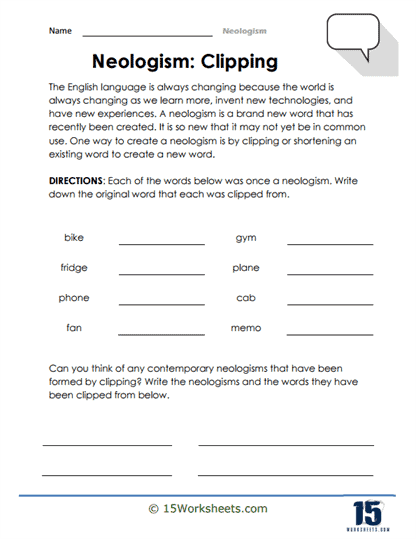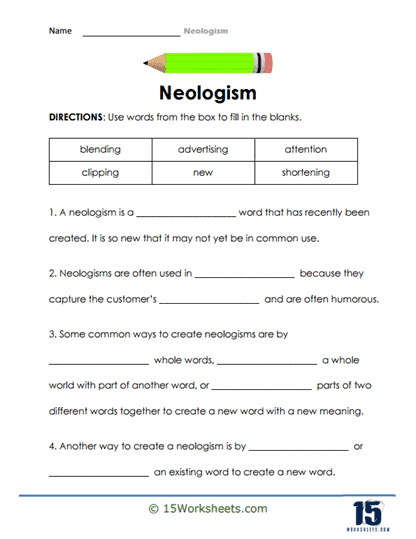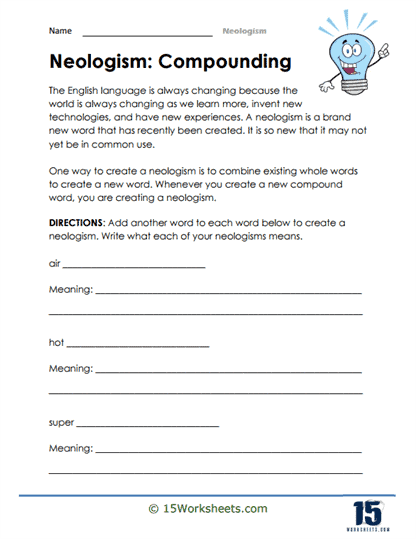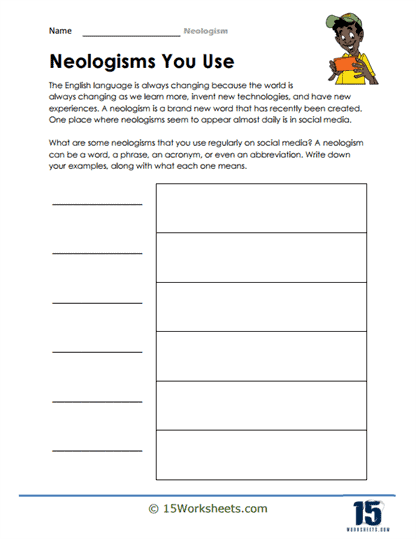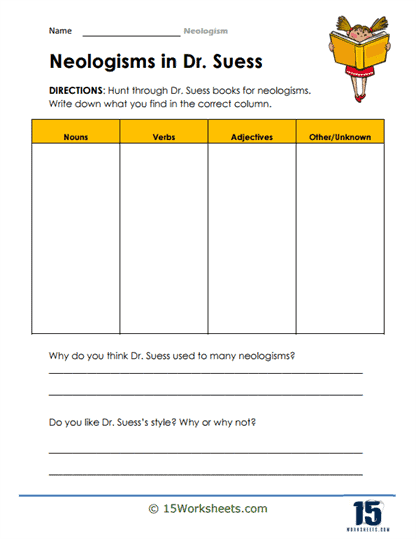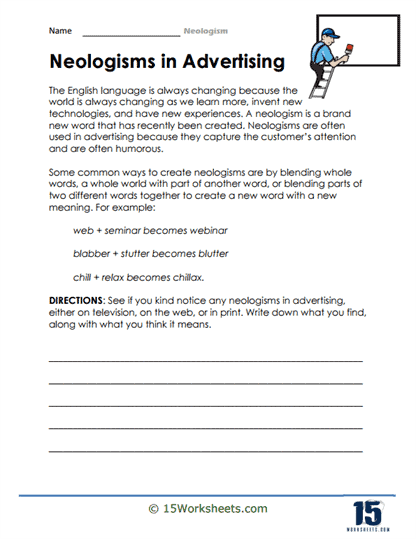Neologism Worksheets
About These 15 Worksheets
In the vast landscape of language, words are constantly evolving, being coined, and adapted to suit the needs and nuances of communication. Among the myriad tools to navigate this linguistic terrain, neologism worksheets stand out as a dynamic resource in language education. These worksheets offer a structured approach to exploring, understanding, and applying newly coined words or phrases, fostering creativity, critical thinking, and language proficiency in learners. In this comprehensive exploration, we delve into the essence of neologism worksheets, their various exercises, and the invaluable benefits they offer in enhancing students’ language arts and reading skills.
Before delving into the intricacies of neologism worksheets, it is crucial to grasp the concept of neologisms themselves. Neologisms refer to newly coined words, expressions, or meanings that emerge within a language, often reflecting shifts in society, technology, or culture. They may arise organically through linguistic innovation or deliberate creation to address emerging concepts or phenomena. Neologisms contribute to the dynamism and adaptability of language, reflecting the ever-changing landscape of human experience.
Neologism worksheets serve as a platform for engaging with these novel linguistic constructs, offering students a structured framework to explore and integrate them into their vocabulary repertoire. By engaging with neologism worksheets, students embark on a journey of linguistic discovery, honing their language skills while nurturing creativity and critical thinking.
Through diverse exercises encompassing vocabulary acquisition, word formation, contextual application, critical analysis, and creative expression, students enhance their language arts and reading skills while nurturing creativity, critical thinking, and cultural literacy. By practicing with neologism worksheets, students embark on a journey of linguistic discovery, enriching their understanding of language and communication in profound and transformative ways.
Types of Exercises
Neologism worksheets encompass a diverse array of exercises tailored to cater to different learning styles and objectives. These exercises range from simple word recognition tasks to complex applications of neologisms in context, providing students with varied opportunities to engage with these novel linguistic constructs. Below, we explore some of the most common types of exercises found in neologism worksheets:
1. Vocabulary Acquisition – At its core, neologism worksheets serve as a vehicle for expanding students’ vocabulary repertoire by introducing them to newly coined words or phrases. In this exercise, students are presented with a list of neologisms along with their definitions or contextual usage. They are tasked with familiarizing themselves with these novel terms, understanding their meanings, and discerning their appropriate usage in different contexts.
Example Exercise:
Neologism – “Infodemic”
Definition – A proliferation of misinformation or disinformation, particularly through digital media channels, often exacerbating public confusion or panic during crises.
2. Word Formation – Word formation exercises challenge students to analyze the structural components of neologisms and derive their meanings based on morphological patterns. By deconstructing and reconstructing these novel terms, students gain insight into the underlying principles of word formation while expanding their analytical and deductive reasoning skills.
Example Exercise:
Neologism – “Techlash”
Word Parts – “Tech” (short for technology) + “Lash” (suggesting backlash)
Meaning – A widespread negative reaction or criticism directed towards the technology industry or its practices.
3. Contextual Application – Contextual application exercises prompt students to apply newly acquired neologisms in diverse linguistic contexts, including sentences, paragraphs, or scenarios. By integrating these novel terms into contextually relevant settings, students deepen their understanding of their meanings and usage while honing their language production skills.
4. Critical Analysis – Critical analysis exercises encourage students to evaluate the significance and implications of neologisms within broader socio-cultural or linguistic contexts. By critically examining the origins, usage, and cultural connotations of these novel terms, students develop a nuanced understanding of their socio-linguistic relevance and impact.
5. Creative Expression – Creative expression exercises empower students to unleash their creativity and linguistic flair by incorporating neologisms into original compositions, such as narratives, poems, or dialogues. Through creative experimentation with language, students not only deepen their understanding of neologisms but also cultivate their expressive and imaginative capacities.
Benefits of These Worksheets
Engaging with neologism worksheets offers a multitude of benefits that extend beyond mere vocabulary acquisition, enriching students’ language arts and reading skills in profound ways. Here are some of the key benefits of practicing with neologism worksheets:
1. Vocabulary Enrichment
Neologism worksheets serve as a rich repository of novel vocabulary, allowing students to expand their lexical repertoire and deepen their understanding of linguistic diversity. By encountering and internalizing a wide range of neologisms, students enhance their language proficiency and communicative effectiveness across various domains.
2. Critical Thinking Skills
Analyzing and synthesizing neologisms necessitates critical thinking skills, as students must discern the underlying meanings, origins, and implications of these novel linguistic constructs. Through exercises that prompt critical analysis and reflection, students cultivate their ability to evaluate information critically, make informed judgments, and navigate complex linguistic landscapes with discernment and insight.
3. Creative Expression
Neologism worksheets provide a platform for creative expression, inviting students to explore the boundaries of language and imagination. By incorporating neologisms into original compositions, students unleash their creative potential, experiment with linguistic forms, and develop their expressive capacities. This creative engagement fosters a deeper appreciation for the versatility and beauty of language while nurturing students’ confidence and self-expression.
4. Contextual Understanding
Practicing with neologism worksheets facilitates a nuanced understanding of language within diverse socio-cultural contexts. By exploring the usage and connotations of neologisms in different settings, students develop sensitivity to language variation, register, and pragmatics, enhancing their communicative competence and cultural literacy.
5. Language Acquisition
Engaging with neologism worksheets augments language acquisition by providing contextualized exposure to novel linguistic constructs. Through repeated exposure and practice, students internalize these neologisms, integrating them into their active vocabulary and language production repertoire. This process of language acquisition is facilitated by meaningful engagement with neologism worksheets, which offer structured opportunities for repetition, reinforcement, and application.
What is the Literary Device of Neologism?
Neologism, a literary device integral to the evolution of language and literature, involves the creation or usage of new words, expressions, or meanings for existing words. This innovative linguistic tool allows authors to extend the boundaries of language, offering fresh ways to convey complex ideas, emotions, and experiences. The main defining feature of a neologism is its novelty. It is a word or phrase that is either entirely invented or repurposed with a new meaning distinct from its original usage. This novelty can stem from various sources, including the blending of existing words, borrowing from other languages, or the creative restructuring of linguistic norms.
Characteristics of Neologism
Innovation – They introduce new terms into a language, expanding its vocabulary.
Adaptability – They reflect the dynamic nature of language, adapting to cultural shifts, technological advancements, and new concepts.
Expressiveness – Neologisms often provide a more precise or nuanced way to express ideas, filling gaps in the existing lexicon.
Cultural and Historical Context – They can encapsulate specific moments in time, embodying the cultural and societal milieu from which they emerge.
Variability – Their acceptance and longevity vary; some neologisms become permanent additions to the language, while others fade into obscurity.
Examples of Neologisms in Literature
“Cyberspace” in William Gibson’s Neuromancer – Before Gibson coined the term, the concept of a global digital realm was largely unimagined. “Cyberspace” encapsulated the idea of a vast, interconnected digital space that exists beyond the physical world. This neologism not only defined a fundamental aspect of the internet age but also influenced the development of digital culture and online identity. Gibson’s use of “cyberspace” expanded the lexicon to include a concept that has become central to contemporary life, illustrating the predictive power of literature.
“Doublethink” in George Orwell’s 1984 – Orwell introduces “doublethink” as the power of holding two contradictory beliefs in one’s mind simultaneously, accepting both of them. This neologism is critical to the novel’s exploration of totalitarianism, propaganda, and the manipulation of thought. By inventing “doublethink,” Orwell provides a concise, powerful word to describe a complex psychological phenomenon, enriching discussions on political discourse and the nature of belief.
“Quark” in James Joyce’s Finnegans Wake – Joyce’s use of “quark” for a soft sound in his complex narrative exemplifies his linguistic inventiveness. Later, physicist Murray Gell-Mann adopted the term to name a fundamental particle in theoretical physics, demonstrating the impact of literary neologisms beyond the realm of literature. Joyce’s “quark” highlights the playful, exploratory nature of language, where a word invented in a literary context can cross into scientific terminology.
The Effect of Neologism on the Reader
Neologisms can profoundly impact readers, affecting their experience and interpretation of a text in several ways:
Cognitive Engagement – Encountering new words requires readers to engage more deeply with the text to decipher meanings, often leading to a more active reading experience.
Immersive World-building – In fiction, especially science fiction and fantasy, neologisms contribute to the creation of unique worlds, societies, and cultures, enhancing the immersive quality of these narratives.
Emotional and Intellectual Resonance – Neologisms can encapsulate complex emotions or ideas in a single, potent term, fostering a deeper emotional and intellectual connection to the text.
Reflection on Language and Society – By pushing the boundaries of language, neologisms encourage readers to reflect on the nature of language itself and its role in shaping societal and cultural norms.
Neologisms are not merely linguistic curiosities; they are tools that authors use to navigate the evolving landscape of human thought and culture. Through their creation and deployment of new words, authors can articulate previously inexpressible concepts, enrich the linguistic tapestry, and challenge readers to see the world through a novel lens. Whether solidifying fleeting aspects of the zeitgeist or imagining the uncharted territories of the future, neologisms underscore the power of language to define reality, shape consciousness, and connect disparate realms of human experience. The introduction of a single new word can change the way we understand the world around us, demonstrating the transformative power of literature and the endless possibilities of linguistic creativity.

